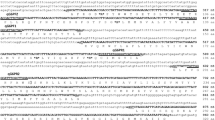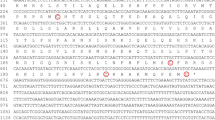Abstract
The crustacean hyperglycemic hormone (CHH) gene of Portunus trituberculatus (Pt-CHH) consists of four exons and three introns spanning 3849 bp in size and generating two mature mRNA, Pt-CHH1, and Pt-CHH2. The primary gene transcript produces a cDNA encoding for the putative Pt-CHH2 from exons 1, 2, 3, and 4 and an alternative transcript encodes for a putative Pt-CHH1 peptide from exons 1, 2, and 4. A promoter fragment of about 3 kb was obtained by genomic walking. The tissue-specific expression pattern is examined by reverse transcriptase chain reaction, and the results show that Pt-CHH1 is detected in the eyestalk, brain, muscle, and blood. However, Pt-CHH2 is detected in the ganglia thoracalis and gill. The results indicate that the expression of Pt-CHH2 in the gill might suggest a potential role in osmoregulation. The Pt-CHH transcript level in the gill increases when the crab is exposed to low salinity. The injection of dsRNA for Pt-CHH causes a significant reduction in Pt-CHH2 transcript level and the activity of Na+/K+-ATPase, and carbonic anhydrase (CA) show a serious decrease. In conclusion, this study provides molecular evidence to support the osmoregulatory function of Pt-CHH2.





Similar content being viewed by others
References
Bansal M, Kumar A, Yella VR (2014) Role of DNA sequence based structural features of promoters in transcription initiation and gene expression. Curr Opin Struct Biol 25:77–85. https://doi.org/10.1016/j.sbi.2014.01.007
Camachojiménez L, Díaz F, Sánchezcastrejón E, Poncerivas E (2018) Effects of the recombinant crustacean hyperglycemic hormones rCHH-B1 and rCHH-B2 on the osmo-ionic regulation of the shrimp Litopenaeus vannamei exposed to acute salinity stress. J Comp Physiol B-biochem Syst Environ Physiol 1:1–15
Camacho-Jiménez L, Sánchez-Castrejón E, Díaz F, Aguilar MB, Muñoz-Márquez ME, Ponce-Rivas E (2017) Cloning and expression of the recombinant crustacean hyperglycemic hormone isoform B2 (rCHH-B2) and its effects on the metabolism and osmoregulation of the Pacific white shrimp Litopenaeus vannamei. Gen Comp Endocrinol 253:33–43. https://doi.org/10.1016/j.ygcen.2017.08.020
Chang ES, Chang SA, Beltz BS, Kravitz EA (1999) Crustacean hyperglycemic hormone in the lobster nervous system: localization and release from cells in the subesophageal ganglion and thoracic second roots. J Comp Neurol 414:50–56
Chen SH, Lin CY, Kuo CM (2004) Cloning of two crustacean hyperglycemic hormone isoforms in freshwater giant prawn (Macrobrachium rosenbergii): evidence of alternative splicing. Mar Biotechnol 6:83–94
Christie AE, Dickinson PS, Stemmler EA (2010) Crustacean neuropeptides. Cell Mol Life Sci 67:4135–4169
Chung JS, Dircksen H, Webster SG (1999) A remarkable, precisely timed release of hyperglycemic hormone from endocrine cells in the gut is associated with dysis in the crab Carcinus maenas. Proc Natl Acad Sci U S A 96:13103–13107
Dai A, Feng Z, Song Y, Huang Z, Wu H (1977) Preliminary investigation on fishery biology of Portunus trituberculatus. J Zool:36–39
Eckhardt E, Pierrot C, Thuet P, Herp FV, Charmantier-Daures M, Trilles JP, Charmantier G (1995) Stimulation of osmoregulating processes in the perfused gill of the crab Pachygrapsus marmoratus (crustacea, decapoda) by a sinus gland peptide. Gen Comp Endocrinol 99:169–177
Furriel RP, Mcnamara JC, Leone FA (2000) Characterization of (Na+, K+)-ATPase in gill microsomes of the freshwater shrimp Macrobrachium olfersii. Comp Biochem Physiol Part B Biochem Mol Biol 126:303–315
Gu PL, Chan SM (1998) The shrimp hyperglycemic hormone-like neuropeptide is encoded by multiple copies of genes arranged in a cluster 1. FEBS Lett 441:397–403
Han X, Gao B, Wang H, Liu P, Chen P, Li H (2014) Effects of low salinity stress on microstructure of gill and hepatopancreas and family survival rate of Portunus trituberculatus. Prog Fish Sci 35:104–110
Henry RP, Campoverde M (2006) Neuroendocrine regulation of carbonic anhydrase expression in the gills of the euryhaline green crab, Carcinus maenas. J Exp Zool Part A Comp Exp Biol 305A:663–668
Henry RP, Garrelts EE, Mccarty MM, Towle DW (2002) Differential induction of branchial carbonic anhydrase and Na+/K+-ATPase activity in the euryhaline crab, Carcinus maenas , in response to low salinity exposure. J Exp Zool 292:595–603
Huang D, Zhang Z, Jia X, Zou Z, Tu C, Wang Y (2017) Functional analysis of the proximal promoter of CHH gene in mud crab (Scylla paramamosain). J Appl Oceanogr 36:87–95
Kamemoto FI (1976) Neuroendocrinology of osmoregulation in decapod crustacea. Am Zool 16:141–150
Keller R (1992) Crustacean neuropeptides: structures, functions and comparative aspects. Experientia 48:439–448
Lacombe C, Grève P, Martin G (1999) Overview on the sub-grouping of the crustacean hyperglycemic hormone family. Neuropeptides 33:71–80. https://doi.org/10.1054/npep.1999.0016
Laetitia S, Gaëlle B, Daniel S, Guy C, Evelyse G, Fabien A, Céline S (2003) Putative involvement of crustacean hyperglycemic hormone isoforms in the neuroendocrine mediation of osmoregulation in the crayfish Astacus leptodactylus. J Exp Biol 206:979–988
Li L, Luqing P, Dongxu H, Dong L, Maoqi L (2017) The effect of bilateral eyestalk ablation on signal transduction pathways of ion regulation of Litopenaeus vannamei. J World Aquacult Soc 48:145–155
Lu WQ, Wainwright Golohan LA, Webster SG, Rees HH, Turner PC (2001) Characterization of cDNA encoding molt-inhibiting hormone of the crab, Cancer pagurus; expression of MIH in non-X-organ tissues. Gene 278:149–159
Lucu Č, Towle DW (2003) Na+/K+-ATPase in gills of aquatic crustacea. Comp Biochem Physiol A Mol Integr Physiol 135:195–214. https://doi.org/10.1016/S1095-6433(03)00064-3
Mantel LH (1985) Neurohormonal integration of osmotic and ionic regulation. Am Zool 25:253–263
Mcnamara JC, Faria SC (2012) Evolution of osmoregulatory patterns and gill ion transport mechanisms in the decapod crustacea: a review. J Comp Physiol B 182:997–1014
Meredith J, Ring M, Macins A, Marschall J, Cheng NN, Theilmann D, Brock HW, Phillips JE (1996) Locust ion transport peptide (ITP): primary structure, cDNA and expression in a baculovirus system. J Exp Biol 199:1053–1061
Miaoan S, Longtao Z, Yufang Z, Hangjiao H, Binpeng X, Xiaoling G (2012) Cloning and expression of two genes encoding type I crustacean hyperglycemic hormone family from the mud crab Scylla paramamosain. Oceanol Limnol Sin 43:695–701
Nan FH, Hong MC, Sheen SS (2004) The effect of unilateral and bilateral eyestalk ablation on haemolymph osmotic and ionic regulation and gill Na+/K+-ATPase activity in Marsupenaeus japonicus (bate, 1888) (decapoda, natantia). Crustaceana 77:385–395
Pan L, Liu H (2005) Review on the osmoregulation of crustacean. J Fish China 29:109–114
Ponprateep S, Tharntada S, Somboonwiwat K, Tassanakajon A (2012) Gene silencing reveals a crucial role for anti-lipopolysaccharide factors from Penaeus monodon in the protection against microbial infections. Fish Shellfish Immunol 32:26–34
Sedlmeier D (1985) Mode of action of the crustacean hyperglycemic hormone. Am Zool 25:223–232
Shuanglin Z, Naicheng J, Jianping L, Wanxi Y (2001) Progress of the study on osmotic regulation in crustaceans I. The gill's structure and function and its' concerned factors. Donghai Marine Science 19:45–52
Spanings-Pierrot C, Soyez D, Herp FV, Gompel M, Skaret G, Grousset E, Charmantier G (2000) Involvement of crustacean hyperglycemic hormone in the control of gill ion transport in the crab Pachygrapsus marmoratus. Gen Comp Endocrinol 119:340–350
Tiu SHK, He JG, Chan SM (2007) The LvCHH-ITP gene of the shrimp (Litopenaeus vannamei) produces a widely expressed putative ion transport peptide (LvITP) for osmo-regulation. Gene 396:226–235
Turner LM, Webster SG, Morris S (2013) Roles of crustacean hyperglycaemic hormone in ionic and metabolic homeostasis in the Christmas Island blue crab, Discoplax celeste. J Exp Biol 216:1191–1201
Webster SG, Keller R, Dircksen H (2012) The CHH-superfamily of multifunctional peptide hormones controlling crustacean metabolism, osmoregulation, moulting, and reproduction. Gen Comp Endocrinol 175:217–233
Westenberg M, Heinhuis B, Zuidema D, Vlak JM (2005) siRNA injection induces sequence-independent protection in Penaeus monodon against white spot syndrome virus. Virus Res 114:133–139
Xie X, Dongfa Z, Jifen Y, Xier Q, Xioayu C, Jie T (2014) Molecular cloning of two structure variants of crustacean hyperglycemic hormone (CHH) from the swimming crab (Portunus trituberculatus), and their gene expression during molting and ovarian development. Zool Sci 31:802–809. https://doi.org/10.2108/zs140053
Funding
This research was supported by the National Natural Science Foundation of China (grant Nos 41776160 and 41576147), Efficient Eco Agriculture Innovation Project of Taishan Leading Talent Project (No. LJNY2015002), Shandong Province Key Development Program for Research (2018GSF121030), Laboratory for Marine Fisheries Science and Food Production Processes, Qingdao National Laboratory for Marine Science and Technology (2016LMFS-A12), Qingdao Applied Basic Research Project (17-1-1-95-jch), Special Scientific Research Funds for Central Non-profit Institutes, Yellow Sea Fisheries Research Institute (Project 20603022018027), and the Key Research and Development Plan of Jiangsu Province (BE2017325).
Author information
Authors and Affiliations
Corresponding author
Ethics declarations
Conflict of interest
The authors declare that they have no conflict of interest.
Additional information
Publisher’s note
Springer Nature remains neutral with regard to jurisdictional claims in published maps and institutional affiliations.
Rights and permissions
About this article
Cite this article
Sun, D., Lv, J., Gao, B. et al. Crustacean hyperglycemic hormone of Portunus trituberculatus: evidence of alternative splicing and potential roles in osmoregulation. Cell Stress and Chaperones 24, 517–525 (2019). https://doi.org/10.1007/s12192-019-00980-6
Received:
Revised:
Accepted:
Published:
Issue Date:
DOI: https://doi.org/10.1007/s12192-019-00980-6




